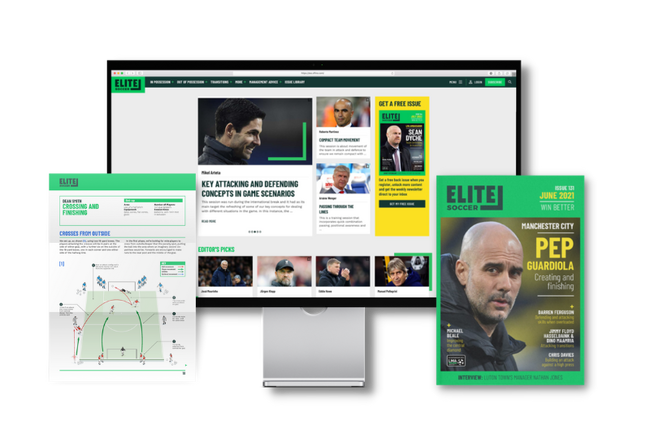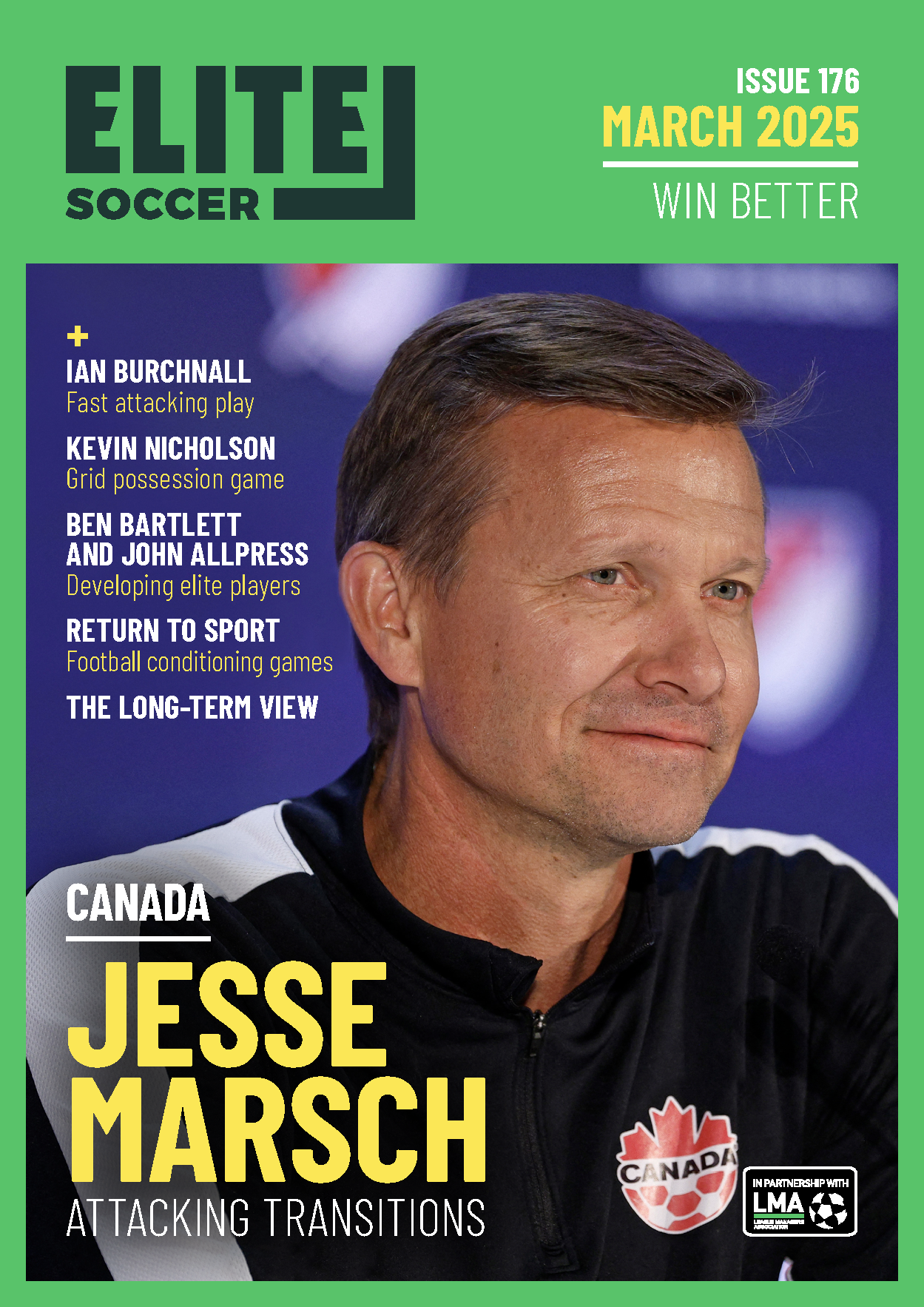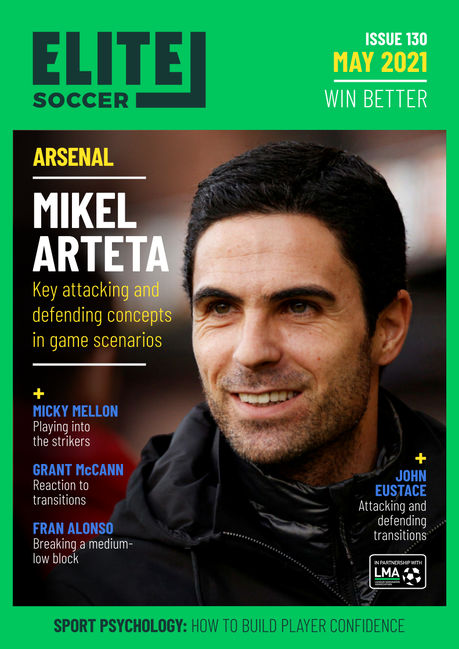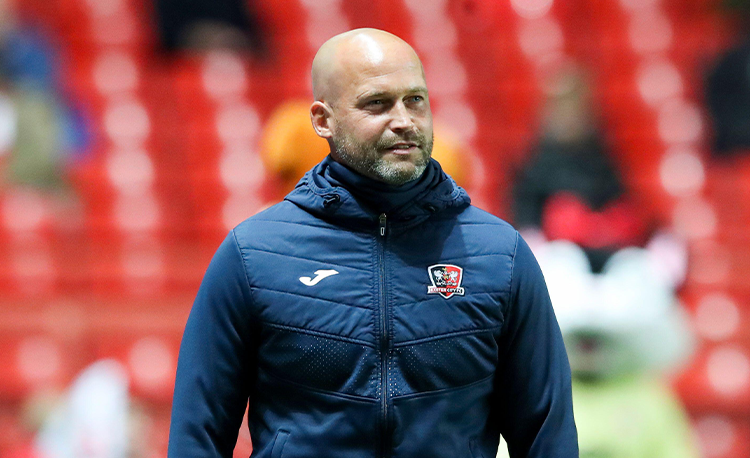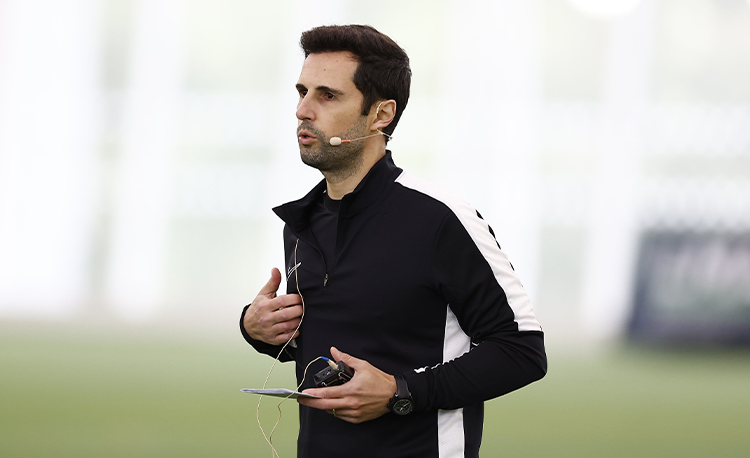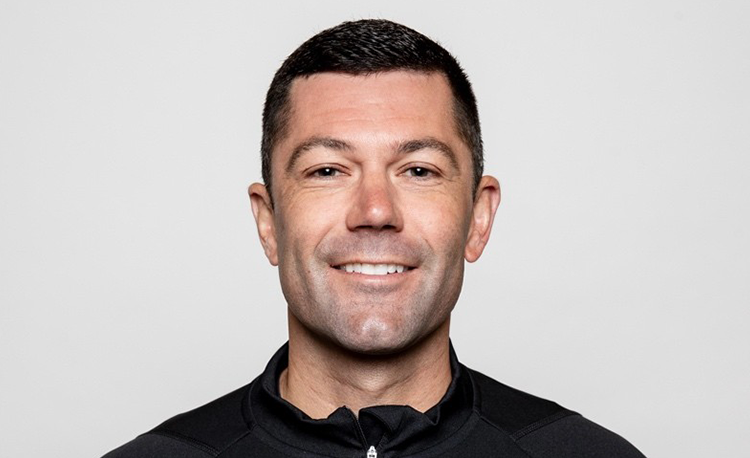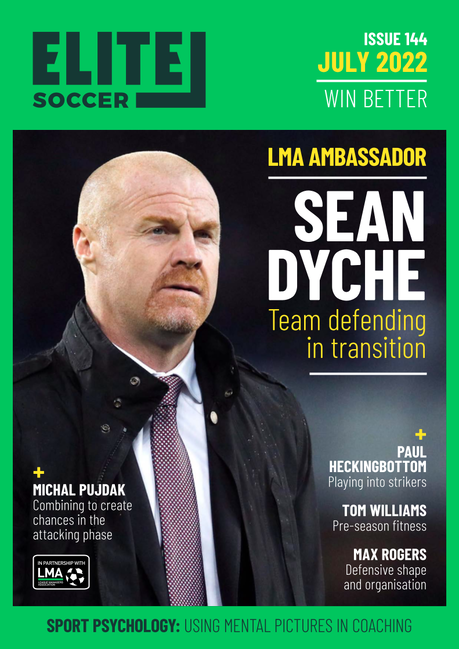Sustaining and finishing attacks
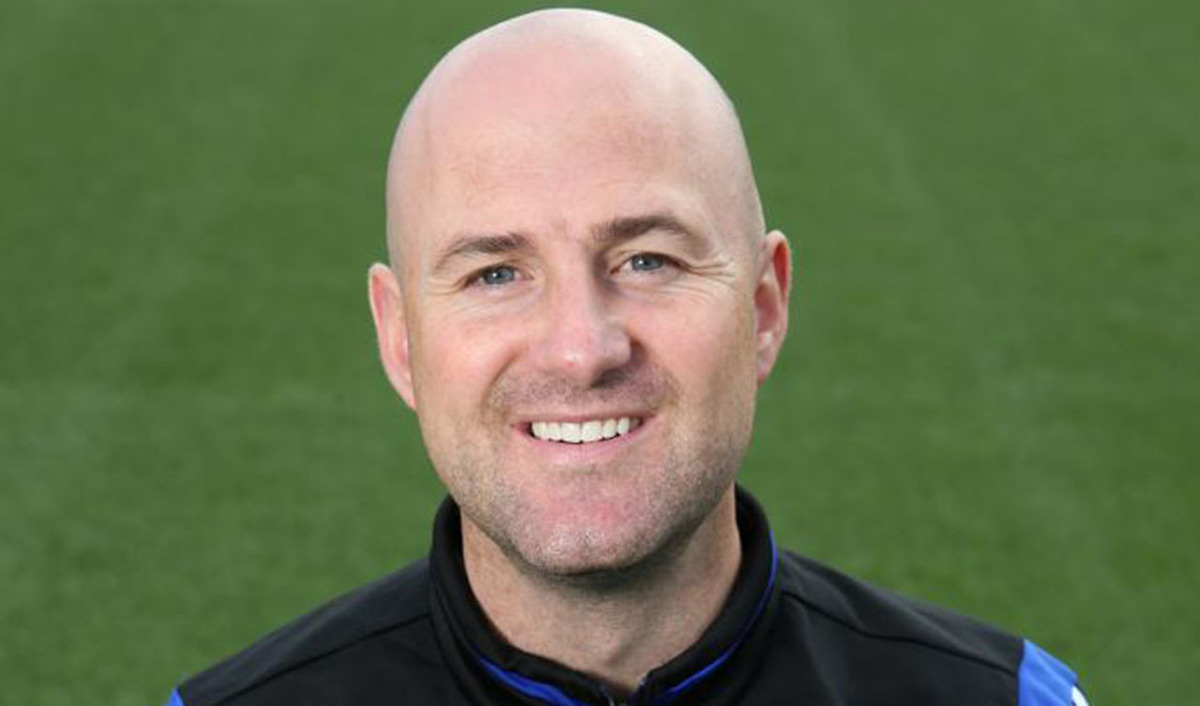
| Area | Up to three quarters of pitch |
| Equipment | Balls, bibs, cones, mannequins or poles, 4 small goals, 1 full size goal |
| No. of Players | 20 players + 1 goalkeeper |
| Session Time | Skill & technique practice: 20mins Possession practice: 20mins Attacking phases of play: 20mins |
This session is made up of a series of practices that work on the abilities of individuals and the team to sustain attacks and ultimately finish attacks. It opens with a practice that focuses on attacking in 1v1s and 2v2s, as well as forward passing and playing off one-touch. It works on playing forward through the units first time with the correct ball speed to break lines.
As the session develops, the second activity works on the team’s ability to sustain the ball against opponents who are using a compact block and who are ready and willing to press aggressively. It’s an activity that helps to develop the shape of the group and shows the players how to play around the block, over the block and in between the block. It also works on the ability of the team to counter-press when possession is lost, showing the players how to recover the ball to again build and sustain constant pressure with the ball.
The session culminates in a phase of play exercise that requires the team to sustain constant pressure with the ball in the opposition half. It utilises tactical situations to be able to exploit the opposition block, using the team’s good movement off the ball, its individual creativity and its passing and dribbling.
This session is unique and engaging as it incorporates both individual development and group development. With the progression of the practices the players are moving through an individual skill development practice to a unit practice to a team practice. There is lots of variety to the practices and plenty of opportunities to embed the key coaching points within the session. The practices are challenging for both the individual and for the team.
“There is lots of variety to the practices and plenty of opportunities to embed the key coaching points within the session”
SKILL & TECHNIQUE PRACTICE
We start with a skill and technique practice and work on attacking 1v1s and 2v2s, as well as forward passing and playing off one-touch.
We set up adjacent grids of 36x12 yards with two mannequins in the centre of each and a small target goal positioned at the top end.
We’re using three players in each grid: a yellow midfield player, a red attacker and a blue defender. We run the same passing/attacking sequence in each grid.
The yellow player starts by passing the ball to the red attacker, who is positioned to the side of the mannequin. The red attacker sets the ball back to the yellow, who then punches a longer pass into the blue defender at the top end of the grid. The blue defender sets the ball back with one-touch to the red player and the red then attacks the blue defender in a 1v1 situation with the aim of scoring in the mini goal at the top end of the area, as shown [1a]. We would run this in blocks of two minutes.
“These passing drills work on pre-movements to receive and setting the ball first time. They also work on being in a position to receive and protect the ball”
[1a]
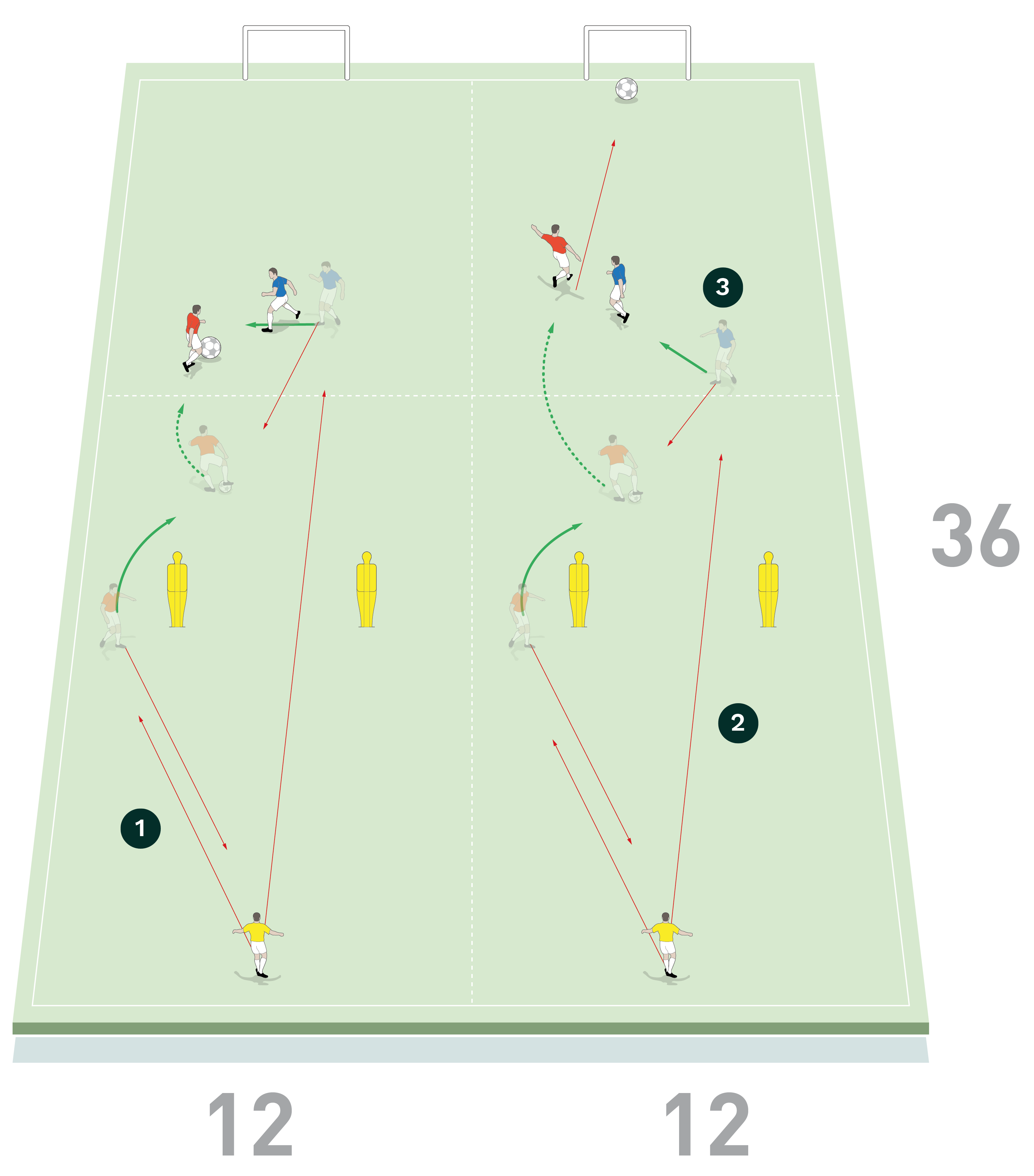
2. The red attacker sets the ball back to the yellow player, who then punches a longer pass into the blue defender
3. The blue defender sets the ball back to the red attacker with one touch. The red then attacks the blue defender in a 1v1 situation and attempts to create a shooting opportunity
[1b]

2. The yellow must take a touch to the side as they are being pressed and then make a long chipped pass into the blue defender
3. The blue defender sets the ball with one touch to the red, who has made an attacking run up the grid. The red attacker takes on the blue defender in a 1v1 with the aim of scoring in the mini goal
[1c]
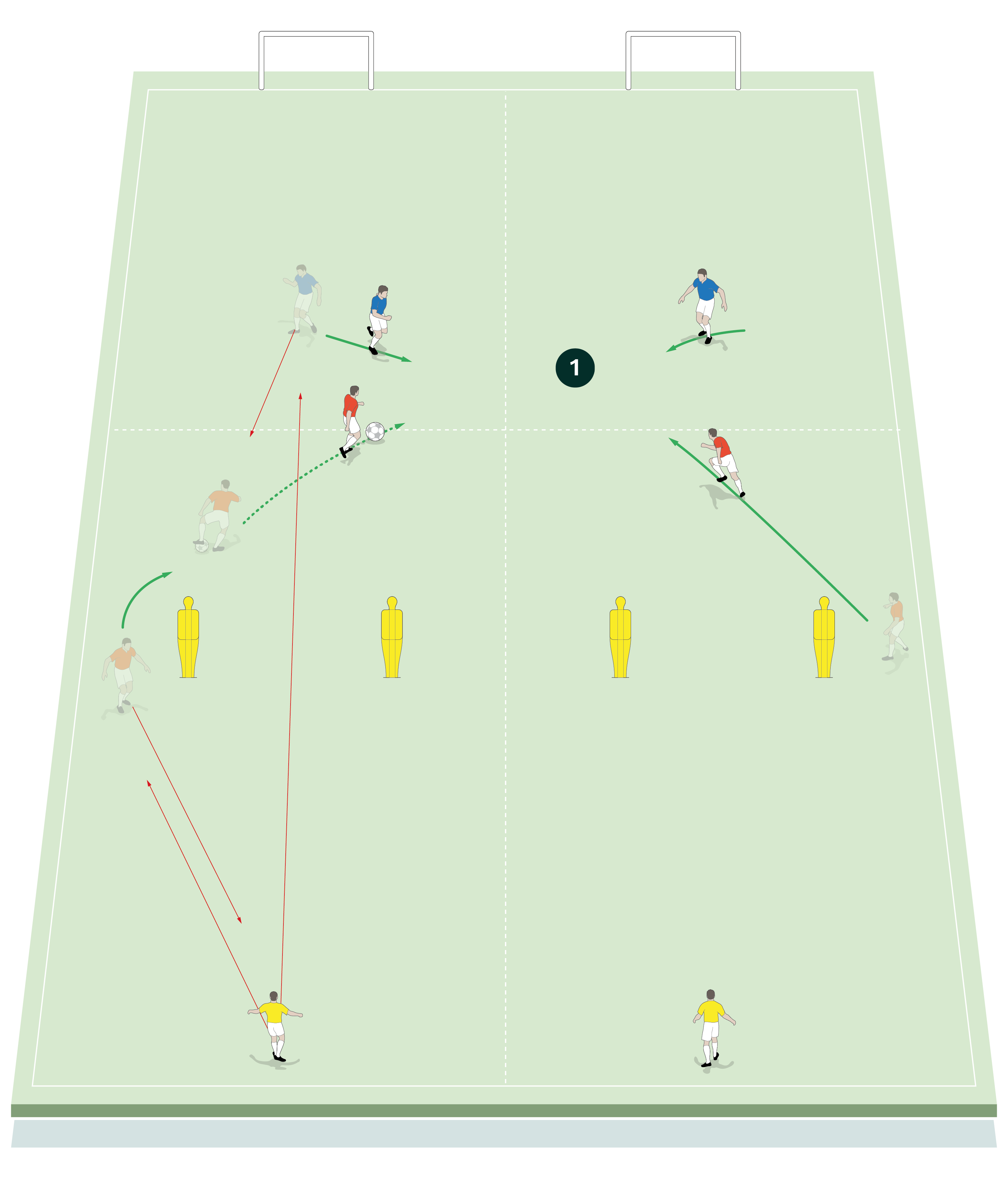
Next we would run a different passing sequence. The red attacker starts with the ball between the mannequins and passes down the grid to the yellow player. The red immediately follows the pass to press the yellow. The yellow must take a touch to the side to avoid the press before playing a long chipped pass into the blue defender at the top end of the area. The blue defender sets the ball with one touch to the red player, who attacks the blue defender in a 1v1 situation with the aim of scoring in the mini goal at the top end, as shown [1b]. We would run this in blocks of two minutes.
These passing drills work on pre-movements to receive and setting the ball first time. They also work on being in a position to receive and protect the ball, and on playing forward through the units first time with the correct ball speed to break lines. They rehearse players in 1v1 attacking and defensive duels and give attackers the opportunity to be able to knock the defender off balance and allows them to use a variety of techniques, feints or tricks to beat the defender and score.
Next we would progress the activity by joining each pair of grids together and we would run the passing sequences again on one side. However, this time when the ball approaches the goal it now becomes a 2v2 situation and the red attacking pair must try to get past the blue defending pair to score in either of the two mini goals, as shown [1c].
This progression encourages quick combination play to exploit defenders and it allows us to work on 2v2 attacks. It encourages the ability to play in pairs, while showing players when to come short and when to penetrate with runs in behind. We would run this in blocks of two minutes.
POSSESSION PRACTICE
We now run a possession practice that will work on the team’s ability to sustain the ball against a compact block that is prepared to press. This activity works the shape of the group to be able to play around the block, over the block and in between the block.
We set up a playing area of 55x30 yards with a mini goal at each end and we mark a central box that contains a pair of mini goals facing outwards, as shown. We’re using 18 outfield players split into a red possession team of eight and a blue pressing team of eight, both playing in the main area, plus two yellow midfielders who play unopposed in the central box.
The coach starts play by passing the ball into the red possession team to start the practice. The reds must attempt to keep the ball from the pressing blue team while trying to find the opportunity to pass to one of the two yellow midfield players in the central box.
Once the ball has been played into one of the yellow midfielders, the yellows aim to link play back to the red possession team, who then try to score by finishing in one of the two out-facing central mini goals, as shown [2a].
[2a]

2. The red possession team of eight attempts to keep the ball by passing
3. The blue team of eight presses and tries to gain possession
4. The red possession team must try to create an opportunity to pass to one of the two yellow midfield players in the pockets
5. The yellow midfielders aim to link play with the red possession team, who try to score by finishing in one of the two central mini goals
[2b]
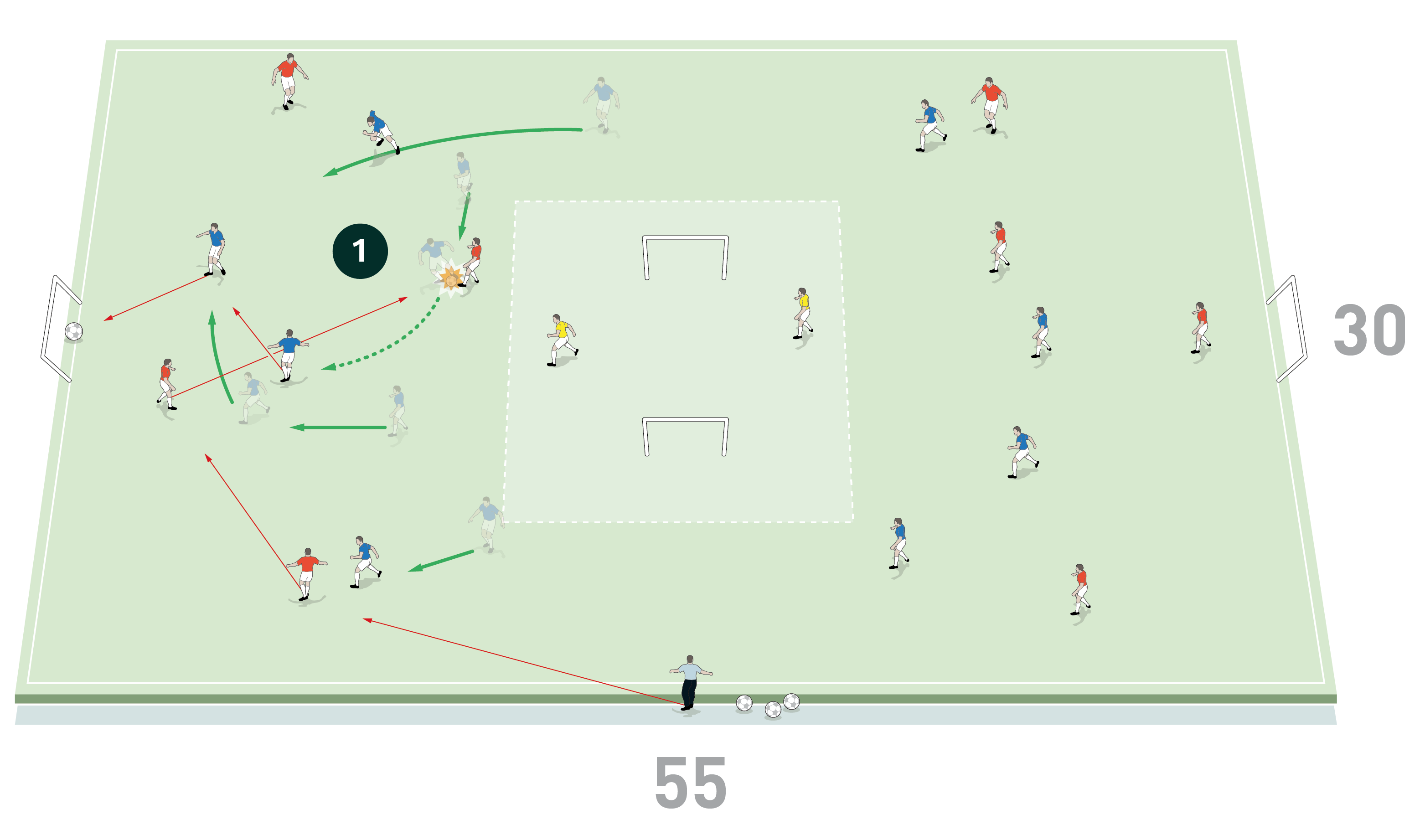
“This activity helps the possession team to recognise when to increase the tempo of the passing in order to pull opponents out of the block”
However, if the blue pressing team wins the ball back successfully, they must try to score as quickly as possible in transition by finishing in one of the two mini goals that are at each end of the playing area, as shown [2b].
This activity helps the possession team to recognise when to increase the tempo of the passing in order to pull opponents out of the block and to enable the possession team to play in between the block to score in one of the mini goals. It works on individual receiving techniques that show players how to be in a position to receive to protect, lend or create, depending on the situation. It develops individual decision-making when receiving and encourages one-touch passing and passing over longer distances. It also works on the team’s counter pressing when possession is lost and encourages players to recover to build again and sustain constant pressure with the ball.
ATTACKING PHASES OF PLAY
In the third part of the session we work on the team’s ability to sustain constant pressure with the ball in the opposition half. We utilise tactical situations to be able to exploit the block, using the team’s individual creativity and their off-the-ball movement.
We set up a playing area on three quarters of a pitch (64 yards in length and using the full width). We position a full size goal and a goalkeeper at one end and three small goals at the other end. We divide the playing area into five channels, as shown. We’re using 20 outfield players split into two teams, with the red possession team set up in a 3-5-2 formation and the blue defending team set up in a 4-4-1-1 system, as shown [3a].
We work on the attacking shape of the red team and outline specific tactical pictures for the players once the ball is in the sustaining phase, showing them how to exploit the opposition in their defensive half.
[3a]
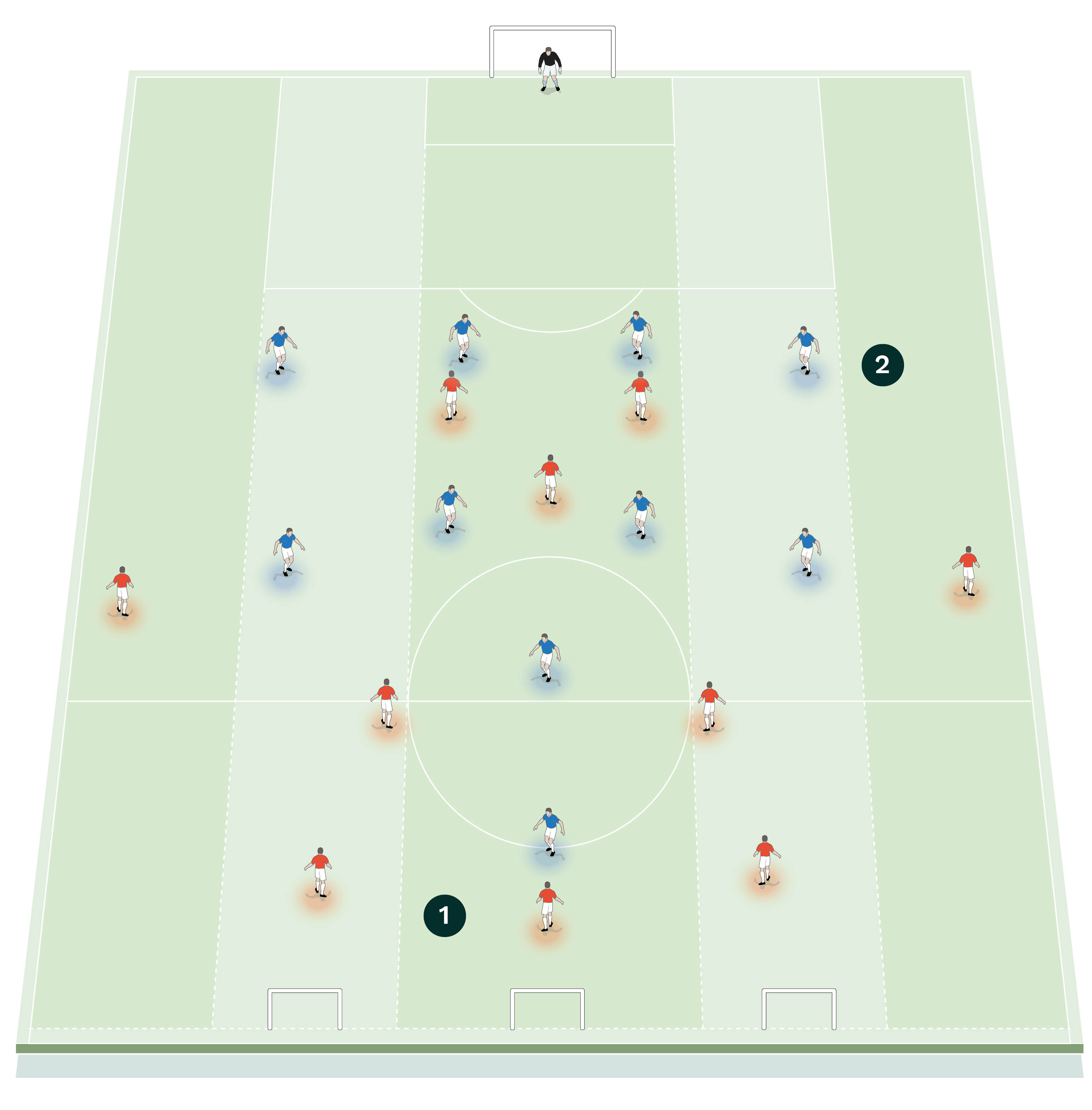
2. The blue defending team is set up in a 4-4-1-1 system and tries to win the ball. If they succeed they must counter-attack the three small goals
[3b]

2. In this first attack the wing back on the ball-side drops down the line to receive
3. The number 10 moves channels to occupy the opposition full back
4. The striker on the ball side makes a run in behind the opposition full back to receive a longer pass played down the side by the wing back. The attack then progresses until the ball is dead
We work on the cohesion of the team and encourage players to recognise which tactical solution is required to break down the opposition’s block.
We begin each attacking phase of play with a coach starting play by passing the ball to a red wide centre back. The ball is switched across the back three and then each attack progresses in a different way…
Attack 1: Once the ball is switched across the back three, the wing back on the ball-side drops down the line to receive. Up the pitch the number 10 moves channels to occupy the opposition full back. The striker on the ball-side makes a run in behind the opposition full back to receive a longer pass played down the side by the wing back, as shown [3b]. The attack then progresses until the ball is dead, with the reds aiming to score in the main goal and the blues aiming to win possession and counter-attack the three mini goals. We place a heavy coaching emphasis on the possession team counter-pressing once possession is lost.
Attack 2: Once the ball is switched across the back three, the wing back on the ball-side pushes on into a more advanced position, level with the opposition full back. The striker on the ball-side drops into midfield to create an overload. The number 10 moves to the side into the wide channel. The wide centre back on the ball has two passing options – to play central into the striker who has dropped into midfield or to play wide into the number 10 to keep progressing the play forwards, as shown [3c]. The attack then continues until the ball is dead.
Attack 3: This time the two central midfield players drop into deep positions to pull out the opposition central midfield players. This opens up the space for the wide centre back to play a through pass into the striker on the ball-side, who has dropped in to receive.
[3c]
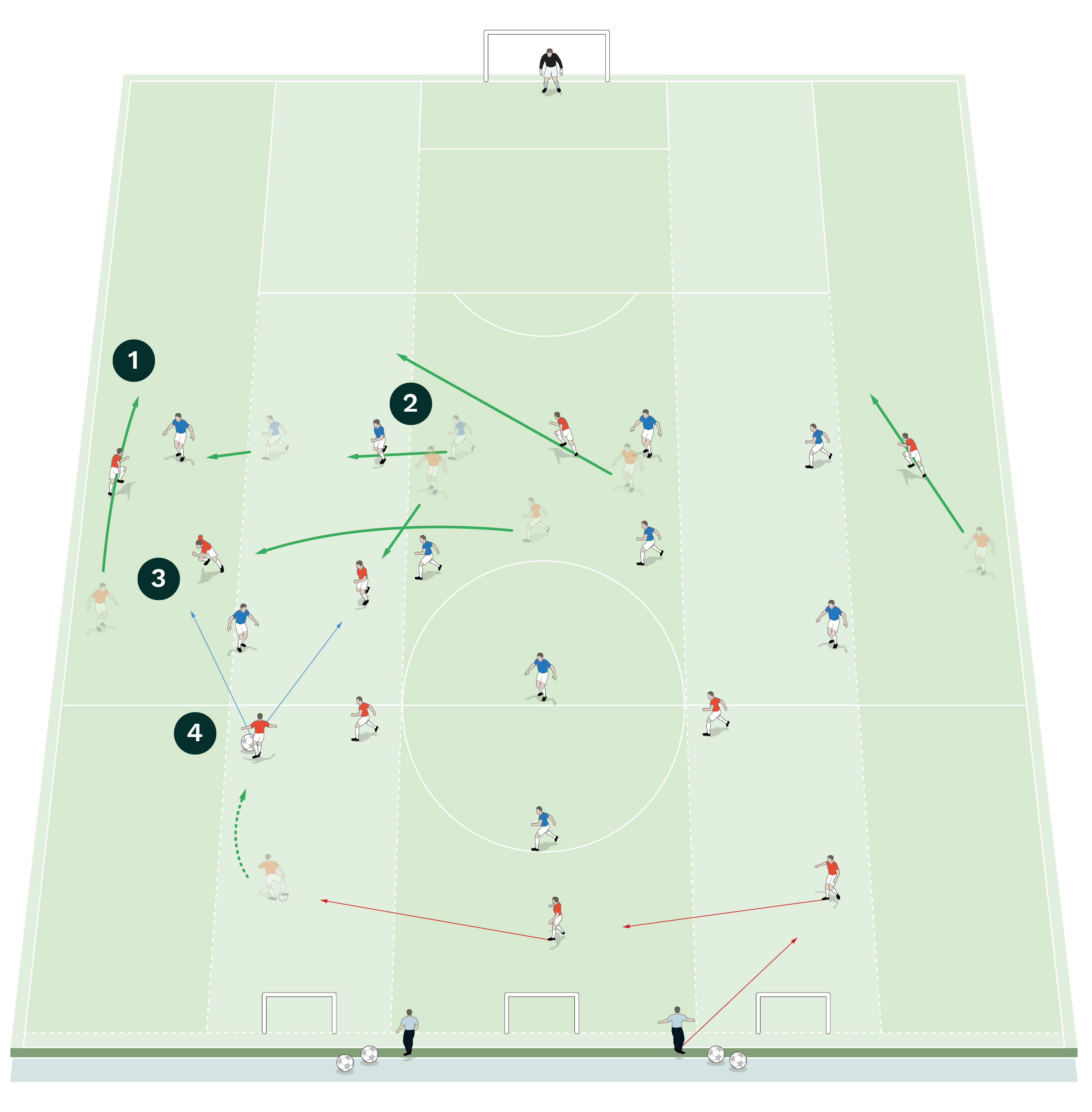
2. The red striker on the ball side drops into midfield to create an overload
3. The red number 10 moves to the side into the wide channel
4. The wide centre back has two passing options – to play central into the striker who has dropped into midfield, or to play wide into the number 10 to keep progressing the play forwards. The attack continues until the ball is dead
[3d]
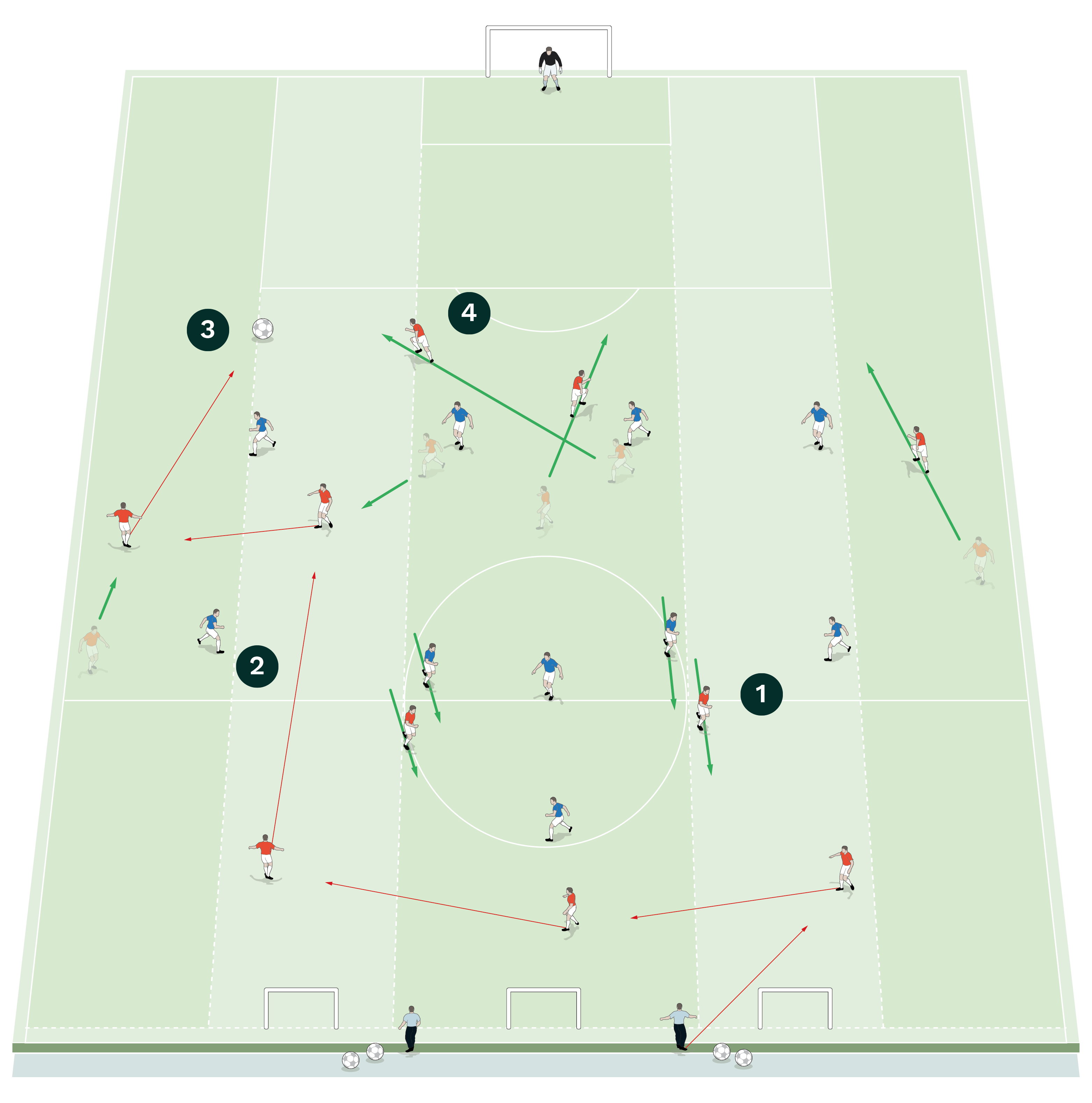
2. Space has opened up for the wide centre back to play a through pass into the striker on the ball side, who has dropped in to receive
3. The striker links with the wing back, who then plays a first time pass in behind the opposition back four
4. The second striker makes a diagonal run in behind to receive the pass. The attack continues until the ball is dead
“We work on the attacking shape of the team and outline specific tactical pictures for the players once the ball is in the sustaining phase”
The striker links with the wing back, who can then play a first-time pass in behind the opposition back four for the second striker to receive, having made a diagonal run in behind, as shown [3d]. The attack then progresses until the ball is dead.
Attack 4: This time the wide centre back steps out with the ball and hits a long diagonal pass to the wing back on the opposite side of pitch, who has made a run in behind. The striker drops into midfield to attract the opposition centre back and full back and the number 10 makes a run in behind to support the attack, as shown [3e]. The attack then progresses until the ball is dead.
As each phase of play is played out until the ball is dead, it is important that the players work hard on the finishing phase of each attack. We want to see players arriving in the penalty area for finishes from crosses or through balls, either shooting first-time or using minimal touches. We also want to see attacking runs off the ball to exploit the opposition defenders.
Players can become frustrated during this practice if they are struggling to break down the defensive block, so it’s important to highlight that this is a difficult task and that players must stay positive with one another.
After working through the various attacking tactical pictures, we would finish the session by progressing this activity into an 11v11 game.
[3e]
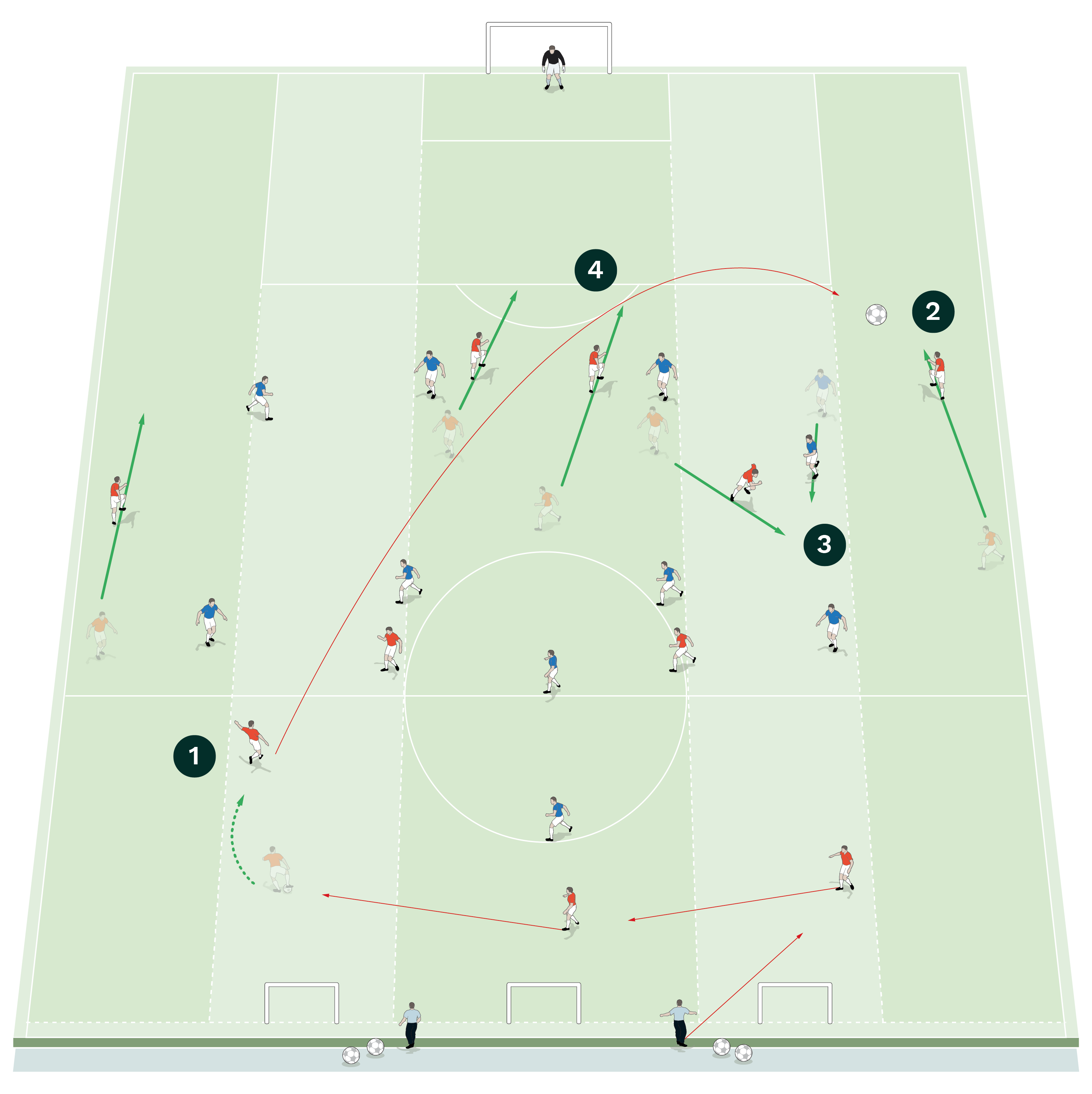
2. The wing back makes a run in behind to receive the switch of play
3. The striker drops into midfield to attract the opposition centre back and full back
4. The number 10 makes a run in behind to support the attack. Play continues until the ball is dead
Editor's Picks
Attacking transitions
Jesse Marsch
Deep runs in the final third
Fabian Hürzeler
Using the goalkeeper in build-up play
Ralph Hasenhüttl
Intensive boxes drill with goals
Andoni Iraola
Penetrating the final third
Ange Postecoglou
Creating and finishing
Pep Guardiola
My philosophy
Sir Alex Ferguson
Pressing initiation
Mauricio Pochettino
Compact team movement
Roberto Martinez
Coaches' Testimonials

Alan Pardew
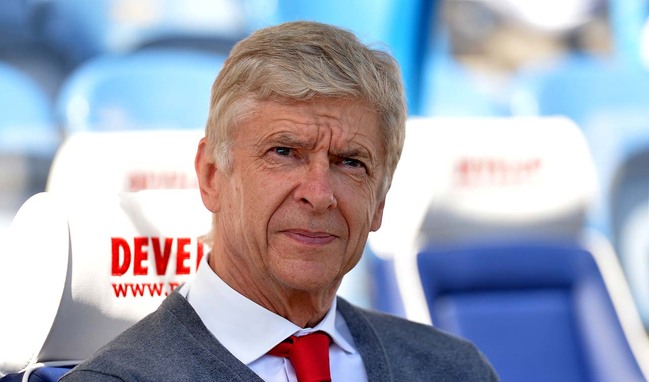
Arsène Wenger

Brendan Rodgers
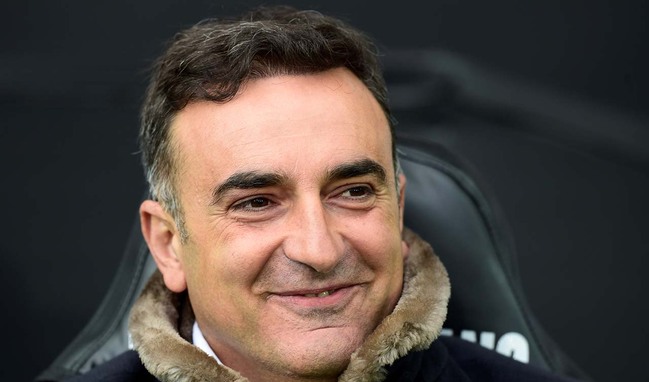
Carlos Carvalhal
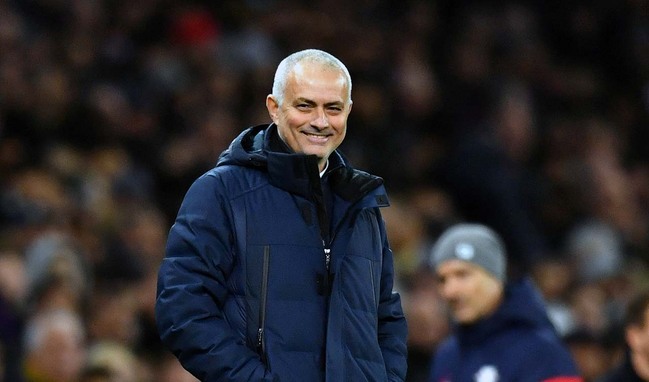
José Mourinho
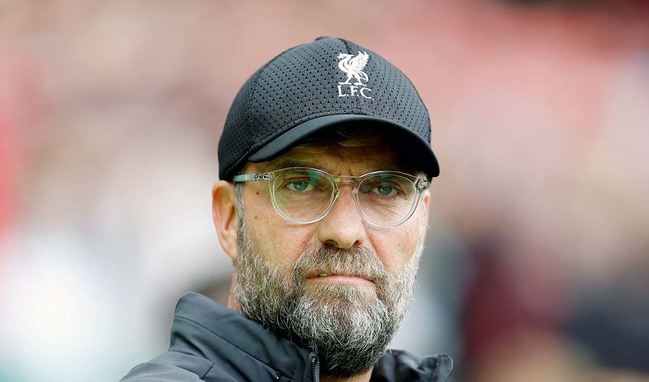
Jürgen Klopp

Pep Guardiola
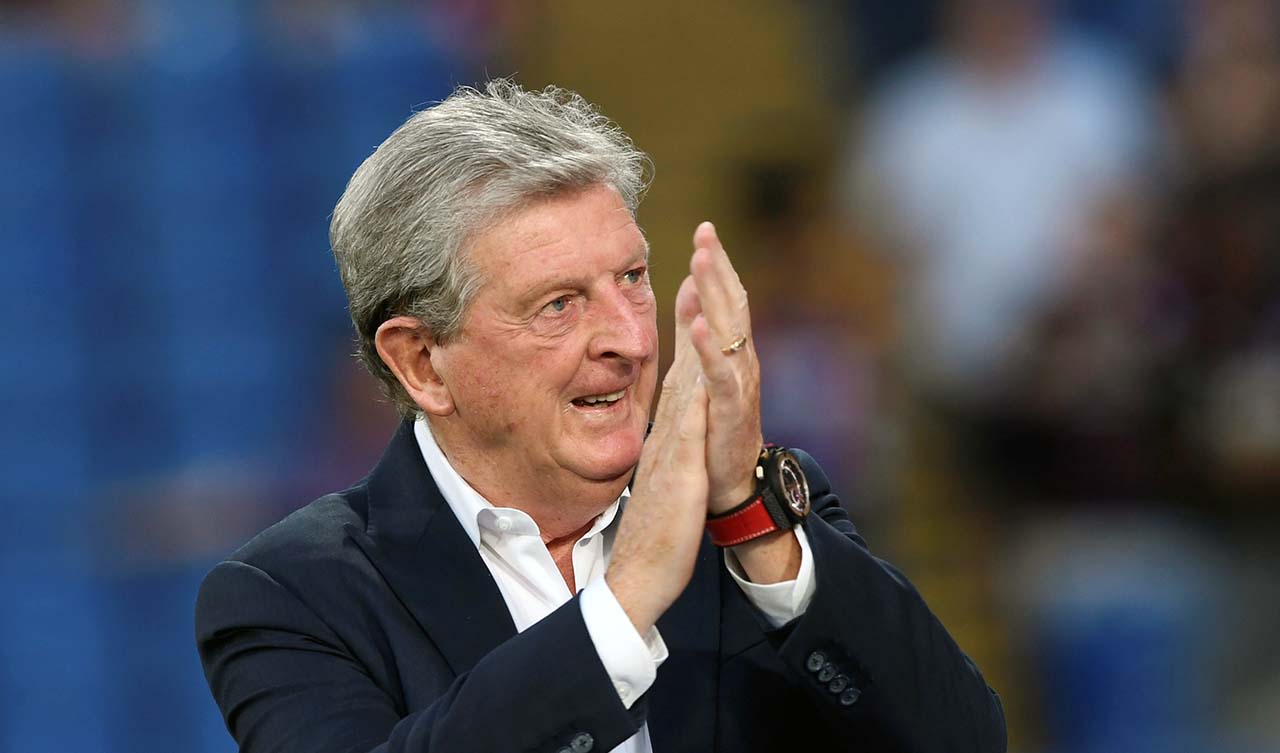
Roy Hodgson
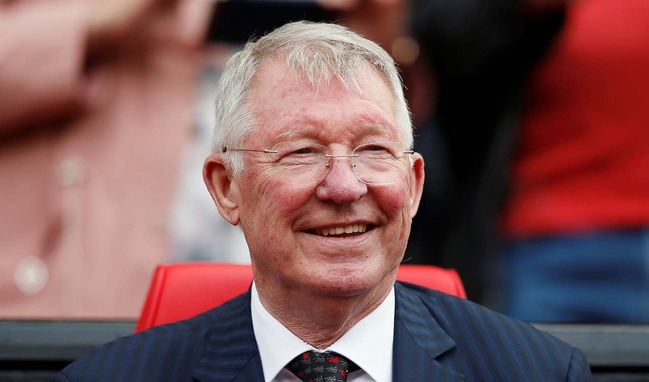
Sir Alex Ferguson

Steven Gerrard
Coaches' Testimonials

Gerald Kearney, Downtown Las Vegas Soccer Club

Paul Butler, Florida, USA

Rick Shields, Springboro, USA

Tony Green, Pierrefonds Titans, Quebec, Canada
Join the world's leading coaches and managers and discover for yourself one of the best kept secrets in coaching. No other training tool on the planet is written or read by the calibre of names you’ll find in Elite Soccer.
In a recent survey 92% of subscribers said Elite Soccer makes them more confident, 89% said it makes them a more effective coach and 91% said it makes them more inspired.
Get Monthly Inspiration
All the latest techniques and approaches
Since 2010 Elite Soccer has given subscribers exclusive insight into the training ground practices of the world’s best coaches. Published in partnership with the League Managers Association we have unparalleled access to the leading lights in the English leagues, as well as a host of international managers.
Elite Soccer exclusively features sessions written by the coaches themselves. There are no observed sessions and no sessions “in the style of”, just first-hand advice delivered direct to you from the coach.
